 Many consumers think of Chardonnay as one very general category of wine type, and the idea of 'California Chardonnay' is even further homogenized together, the only differences being 'cheap' vs 'expensive' or 'bad' vs 'good'. Oaky and buttery flavors are usually the primary flavors that get associated with these Chardonnays, but they aren't the flavors of the grape itself. They are added on through the barrel aging process, they don't HAVE to be there, the grape can present itself with more nuance without a lot of help. More and more these days there are producers pulling back on the reins of their barrel use, especially when they have access to a unique and distinctive vineyard site like this one. Jacks' Hill is just inland from what is probably Monterey's most famous vineyard (Sleepy Hollow) and contains some very under-appreciated older parcels that winemaker Ian Brand sources for this wine, which he builds with multi-use oak barrel, concrete and steel tanks to get a Chablis-inspired wine that still has a lot of the Californian earmarks. Rich lemon curd and zesty tropical fruit aromas with cool and tempering mineral notes that get bolder the longer the wine opens up. The palate has plenty of leesy fruit flesh and melon skin texture, and a distinct extra oompf of rich fruit that is the signature of the Wente Chardonnay clone, which even without a lot of oaky/buttery flavors is about as Californian as you can get. Great for sipping but outstanding with all sorts of fleshier seafood and white meat dishes, really versatile.
0 Comments
 When you have grape vines isolated on an island for many centuries, unique things start to happen. The varieties evolve in their own environment, mutate, and over time can become vastly different from what they are on the mainland. Sometimes they can even become different from themselves on the same island, if the terrain can isolate them enough. Graciano is a variety primarily known in Spain as a background compliment to Tempranillo in Rioja, but at some point was brough over to Sardinia and became prolific across the island. Over time the Sardinians developed at least 20 synonyms for the grape, and have at least two recognized named varieties that came from the common ancestor, Bovale and Cagnulari. They are distinct enough to have this producer bottle them each separately as their own wines, so they definitely find signature differences within each grape. Bright and savory fruit with a bit of tartness to the red fruit aromas, getting bolder and a bit of sweeter berry tones as it opens and the more rustic sides wear off. Has a rustic side to the palate as well, typical of the wilder nature of the island, but not as chewy as their Bovale by comparison, a bit brighter flavors coming through on the still relatively tannic finish. Unique and fun to try, tasty to match with rustic grilled meats and hearty vegetables.  It's officially full-on Spring time, so it's a good time to start dipping into the incoming waves of new Rose releases. Provence is always a great place to start as they essentially specialize in producing their special style of Rose wine for the world, and there is always lots to choose from. l'Escarelle is a new (to us) producer, but has been received well in recent vintages (described as 'dangerously drinkable' in Vinous for the last vintage) and we were very excited about it for the price when we first got to sample. We think you will be as well. Light and fresh aromas of fresh citrus and wet herbs, classic Provencal nose that speaks so much of the Mediterranean coastal sunshine. The palate is loaded with watermelon and strawberry tones, but lightened by the cool mineral kick that gives you some tanginess on the finish. The label will of course draw many people in, but what's inside will keep you coming back for more. Don't wait for the press to tell you if it's good or not, because it could be long gone by then! 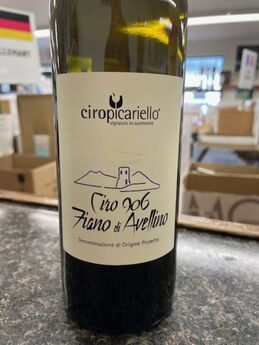 A little nicer than what we usually show in the Insider's Pick, but we wanted to get you as excited about this wine as we are, at least while there is still a bit of it to go around. It isn't often you get the chance to taste people on what is considered one of the very best versions of a grape variety, at least not without having to shell out big bucks to do so. Fiano is the variety, and the high altitude volcanic soils above Naples is considered the optimum site for it to reach it's greatest levels. This version of Fiano is from a single vineyard (Ciro 906 is the registered # of the parcel) that Picariello only feature in what they consider the best vintages. Surprisingly, the winery tends to prefer cooler vintages to do so, intensifying the acidity that allows this wine to evolve for many years after release. Loads of cool crushed stones and stone fruits on the nose, especially right out of the fridge, with warmer melon and pear coming out as it opens up and gets closer to room temperature (if you can leave it alone for that long). The palate is where the wine really separates itself from all others, flooding it with intense minerality, crisp pear and citrus zest, with a mouthfeel that is both big in size and remarkably clean and crystalline on the finish. For this special bottling the winery leaves it on the lees for a full year before bottling, giving the flavors more intensity and generally elevating the entire experience up an extra notch or two. Treat this like a Chablis or great Muscadet and pair it a colossal seafood dish or something fresh and Spring time-y. 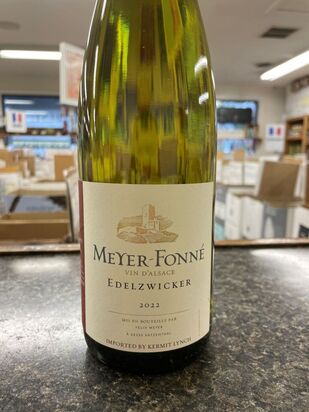 The return of one of our all-time favorite warm weather party sippers in liter form. Alsace is one of the great wine destinations in the world, providing both great juice AND natural/architectural excitement, keeping everyone's senses stimulated. It has in recent years grown more difficult to find value except in the largest of producers, and you tend to lose the charm of the region in most of those. All the more interesting (and surprising) to find a wine blend of this quality and value from one of the region's best-known creators of higher end varietal wines. Do the math here, and this is a $16.99 bottle of wine in a regular bottle, and you get to invite an extra friend over to enjoy it, if you want. The term Edelzwicker and Gentil d'Alsace both mean essentially the same thing as a blend of Alsatian varieties; Meyer-Fonne actually makes both using the same grapes in each, with the younger vines going into the Edelzwicker to make a more easy drinking and everyday wine. Classic Alsatian Five here of Pinot Blanc, Riesling, Muscat, Sylvaner and Gewurztraminer. Those that have a phobia about sweetness may worry about the Muscat and Gewurztraminer, but they are here purely for aromatics. This is drier than 95% of your oaky Chardonnays out there, and infinitely more complex and compelling. Loads of peach and white fruits on the nose with a little zesty lime and magnolia flower, pretty but not overpowering. A nice juicy body that gets a lot of the fruit on the palate, but also immediately minerally with lots of pear skin type drying tannins, leaving you with a nervy lime finish that begs for another sip. Very easy drinking and food friendly. 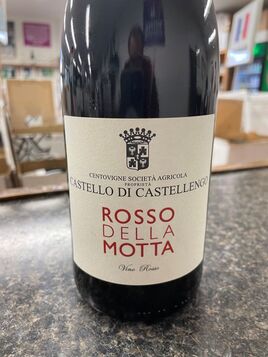 Most wine drinkers 'know' the Piedmont region for the great wines of Barolo and Barbaresco or the prolific production from the areas of Alba and Asti. Recency bias has largely pushed the historical greatness of the Alto Piemonte to the background, so it always makes us happy when we find a wine that helps bring them forward again. At one point the Nebbiolo from Gattinara and Ghemme were every bit the equal of Barolo and Barbaresco, and there were tens of thousands of acres of vineyards across the region. The phylloxera blight decimated the region around the turn of the 20th century and WWII left it in ruins with the loss of workers leaving rural work for jobs in Milan. The winery named itself 'Il Centovigne', or 'One Hundred Vineyards', as their 20 or so acres of vineyards is spread over 37 tiny plots, a sign of the fractured state of the wine industry here. The less expensive wines from here can have a reputation for being lighter or leaner with the stronger Alpine influence, but this one lacks for nothing. Dusty cherry, earth and tobacco notes on the nose that gets a touch of sweetness and black pepper as the wine opens up, showing off the complexity of Nebbiolo. The palate has a juicier, less tannic attack than found in your typical Nebbiolo Langhe thanks to the inclusion of some Vespolina, a featured grape in Alto. It also brings a nice tart cranberry-like note to the finish that makes it more mouthwatering, lingering longer than the tannins and feels quite refreshing. A lovely and distinct Piedmonte red with loads of food possibilities from hearty vegetarian to rustic lighter meats.  From a technical and legal standpoint, we would describe this wine by saying it's a 'baby Bandol'. In our hearts and based on our palates (and channeling our inner Telly Savalas), we would say "it's Bandol, baby!' The Delille family spent more than a decade restoring and renovating the Terrebrune property in Bandol before creating their first commercial vintage in 1980. Much of their strategy, formed in large part with help from their neighbors at the famous Domaine Tempier, involved replanting many parcels of vines that had been poorly created by the previous owners, and even leaving parcels unplanted for an extended time to improve the soil health. As a result their property of roughly 70 acres -all within the borders of Bandol- has vines of vastly different ages. The younger vines are 'declassified' to be used in this more basic bottling, aged for a shorter time in used oak and released young to drink young, but is still dripping with classic Bandol character. Savory currents, dark berry and Provencal herbs pop from the glass at first pour, getting more intense as it opens but staying subtle and cool. A major difference between a true Bandol and a wine at the IGP designation is the alcohol level, where the IGP bottlings generally landing 1%-1.5% less than Bandol. The palate definitely feels lighter because of it, but only by comparison, and also shows a lot less of Mourvedre's intense tannins, allowing the dark herbal flavors to hit your palate a lot easier. The approachability for a wine from this region is almost unheard of, and it gets more compelling the longer it's open. A great wine to take your grilling to the next level. 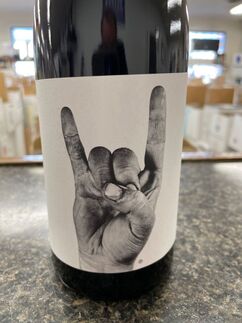 'Don't mess with the bull, or you'll get the horns'. The 'bull' in this case is the Toro wine region in Old Castile, just down the river from Ribera del Duero. Just like its more famous neighbor, Toro has grown grapes for centuries but known for quality only in the past 30-40 years. Their style is also largely built on more modern techniques and characters, richer and extracted, more new oak, etc. So to go against the establishment style is to 'mess with the bull', and that is exactly where the Bigaro wines go, embracing the horns and daring to be different. The wine is 'experimental' in that Kiko calls his own shots and sets his own standards working the fruit from his family's ancient vineyard, building on techniques learned at working wineries on four continents, like following the mantra at harvest 'don't cut fruit you wouldn't eat'. The wine has plenty of size, but not in a dense or heavy way, with lots of dusty dark fruits on the nose from the start, earning a bit of blackberry sweetness and peppery spice the longer it stays open. The palate is very mouthfilling with its unfiltered texture and surprisingly light dusty tannin, allowing the fruit to show through naturally with some unexpected tart notes (boysenberry-ish?) behind the currant and dusky black cherry. The finish is remarkably refreshing for a wine with such dark notes and almost unheard of from the region. A wine for big foods, but not one-dimensional kill-it-and-grill-it dishes, able to handle lots of marinades and savory side dishes. 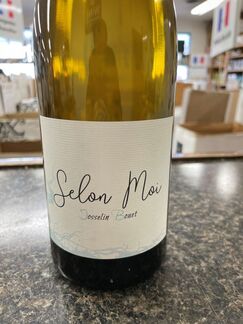 For much of its existence Muscadet was considered a very basic wine region with little potential for making 'great' wines, only straightforward white wines that go great with local seafood but offer little to the outside world. In the late 1980s/early 1990s, a 'New School' developed looking to make more substantial wines from some of the older and more unique vineyard sites, helping them to stand out by aging them on their lees for an extra long period of time to give them more body. The best producers of the time - Pepiere, Michel Bregeon, Luneau-Papin- earned quite a fan following as their wines were routinely described as 'baby Chablis' for their seashell-like saltiness. That 'New School', has now not as new as they once were, but it's great to see more of the new generation they helped to inspire coming into play. New to the area and with a youthful family member at the helm, Bouet checks all the right boxes for making excellent Muscadet. Crisp apple and leesy pear aromas pop from the glass with a hint of wet seashell are the hallmarks of Muscadet, and they're all here. Plenty of natural weight give the apple and pear fruit an extra juiciness on the palate, with a mouthwatering salinity that just begs for something from the sea to pair with it. The brinier the better! 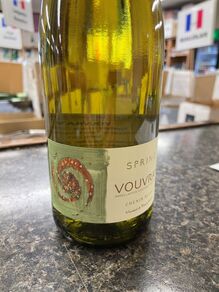 Even though the calendar isn't quite ready to say it for another two weeks, all the signs of Spring are here. The temperature, the budding flowers, the impending Madness that is March, and of course major league baseball's Spring Training (it's in the name, for crying out loud!). Best then to get an early jump on finding your wine choices for the season. While you don't have to limit enjoyment of this wine to just these months, it doesn't need saying Spring on the label for it to just scream it from the glass. Crisp pear and red apple in with the signature Vouvray honeyed aromas, but absolutely dry (sec) and even slightly herbal in a lavender/tarragon way. The palate is cool, clean and mouth-wateringly juicy with a bit of skin tannin to the texture, lots of apple flavors that feel almost crunchy with all the acidity. Very all purpose wine capable of working with creamy fish or white meat courses, lighter Spring salad or just chilled down while you enjoy the sunshine for a change. |
The Best of the Best.We offering free tastings on these wines in the store every Thursday and Friday, and a 10% discount off the retail price through the duration of the day. Come on by and give them a try! Archives
July 2024
Categories |
Location |
|

 RSS Feed
RSS Feed